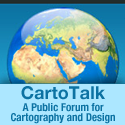Nathaniel
Forum Replies Created
-
AuthorPosts
-
January 24, 2011 at 6:29 pm in reply to: 1:10m Cross-blended Hypsometric Tints in higher resolution – 1:5m? #4128
NathanielKeymasterYou should be able to do this just by using the new TIF you made and laying the ocean over it as a vector file in your normal GIS application.
_Nathaniel
January 24, 2011 at 7:52 am in reply to: 1:10m Cross-blended Hypsometric Tints in higher resolution – 1:5m? #4125
NathanielKeymaster@Torben: You will be stretching Natural Earth past it’s limits to use it in your application. The link I am talking about is here: https://www.naturalearthdata.com/downloads/10m-cross-blend-hypso/cross-blended-hypso/
The ‘large size’ does not have relief shading in it and will scale to your target resolution better. But then it does not have relief shading in it. So you’d need to create that somehow and blend it in (could be as simple as setting the transparency of the hillshade to 50% and overlaying it on top of the above file. It may be better for you to generate a hillshade at 250 meter cell resolution and use that instead. These files get quite large to deal with, besides needing specialized software and requiring hours of time.
Good luck,
_Nathaniel
January 21, 2011 at 7:50 pm in reply to: 1:10m Cross-blended Hypsometric Tints in higher resolution – 1:5m? #4123
NathanielKeymaster@Torben: The suggested approach is to use the hypso with no relief shading from the Natural Earth site and then make your own hillshade and blend the two together for resolutions not at the same scale as the provided data.
NathanielKeymasterThanks for update. I’m working on fixing the 10m_adm_1 for you. I can clip the others to ±180, ±90 bounds as well. It looks like that covers all the errors?
I also see that “10m_admin_0_scale_ranks_with_minor-islands” has a – in the name between minor and islands. That should be fixed to an underscore.
The 10m_adm_0 variants (sov, country, map unit, map subunit) all have expired thematic attribute values. I will update those for you the next couple days (by Thursday).
NathanielKeymasterFor all the themes mentioned above except 10m_admin_1_states_provinces_shp (which I’ll send Monday), please try importing the following files (include the bathymetry, too). I’ve cleaned up the topology in ArcMap using Repair Geometry, deleting null polys and correcting self intersections. I also clipped a few themes that were outside of the ±180, ±90 bounding box. I also modified three continent polygons in the geography label area polys so labels won’t get auto placed in the ocean. http://kelsocartography.com/dropbox/temp/10m_physical.zip
NathanielKeymasterThe bathymetry is a nasty complicated file. Let me repair the geometry on it and see if that cleans it up for you? If you’re not doing anything special with it, you might consider using the rasterized version of that instead.
NathanielKeymasterCan you tell me the difference between the two types of errors?
ERROR: 10m_lakes;GEOS buffer() threw an error!
ERROR: 10m_ocean;POSTGIS2GEOS conversion failed
One looks like an import error based on feature topology. The other looks like an extent error when it tries to do something with the coordinates?
NathanielKeymaster@darkblueb: Thanks for working on the cleaning script for Postgres. I’m sure it will be a great benefit for folks and we can archive a copy of it here. I agree it would be best to rename the fields in the source tables to work with the most end uses. We already limit field names so the files will open in ArcGIS as SHPs and have “_” in file names rather than “-“. When you refer to the numbers in names, do you mean “10m_admin_0” where the leading 1 is causing problems? That’s a bit harder to fix since we need to distinguish between the 3 sets of data. Do you have a recommendation?
NathanielKeymasterYou might ping Mike Migurski at Stamen Design. A forthcoming version of the file will fix these topology errors. They don’t matter for most design and GIS applications. PostGIS seems particularly strict.
_Nathaniel
December 22, 2010 at 5:09 pm in reply to: Q: Free online source for physical or satellite maps including long and lat #4104
NathanielKeymaster@DGreen. Yes, the Natural Earth data will get the job done for you and is one good alternative to Google Earth. But you’ll need to use an app like QGIS to load the data into and composite the layers. You’ll be able to make a map of Sudan approximately 11×17 inches (tabloid size), including generalized “satellite” imagery. You could also pay a Google Earth Pro license fee and get usage rights for the satellite imagery if you already find that app easy to use. If you need setup help, someone at Cartotalk.com could be hired.
NathanielKeymasterThe linework in Natural Earth is designed to register with SRTM derived relief at less than 1 km per pixel. If he’s using older dem/dtm, its positional accuracy might not match. Or if you’ve zoomed in past 1:10 million scale but are using higher res raster, it will not register due to scale missmatch. What area of the world are you mapping, at what scale?
NathanielKeymasterSee if this works: http://forum.qgis.org/viewtopic.php?f=4&t=818
NathanielKeymasterThe physical label areas include point, line, and polygon feature classes. You need to load all three, and likely the polygon version, to see all of them. If you export as EPS, SVG, or PDF, it will open into Illustrator. You will prob. need to turn on the labeling function for the layers. If you poke around a bit you’ll see where that is on the layer properties (I’m not in front of QGIS at the moment).
NathanielKeymaster@Stu: Welcome! There is a pay plugin for Illustrator called MaPublisher that is quite good. But there is also free option called QGIS that works on the Mac. You’ll be able to open the files in that app, do some basic composition, and export as vector and finish designing in Illustrator.
NathanielKeymasterWelcome, Steve! Glad to have you.
NathanielKeymasterGood questions. Likely it’s not showing you the TFW as it’s not a data file in and of itself (kinda like an SHX file is never visible). With the TIF loaded, in ArcGIS Toolbox go to Data Management > Projections and Transformations > Define Projection. Then choose either import one PRJ files from the vector parts of Natural Earth or Select > Geographic Coordinate Systems > World > WGS 1984.prj. Some headers in the TIF have just the registration numbers, not the PRJ coordinate system. It sounds like your setup is either ignoring it, or it is not present in the right way.
NathanielKeymaster@Rok.Geo: You’re very welcome! The raster TIF files include a second world file that acts as a prj file for SHPs. With it you’ll be able to reference other themes on top of one of the Natural Earth rasters. If it is not projecting to your destination coordinate space, use define projection in Toolbox to set to geographic WGS84. ArcMap will then reproject for you.
NathanielKeymaster@JP: Adding a default symbology to Natural Earth is a popular request. Unfortunately, the industry standard shapefile format the project uses for distribution does not allow styling, only the raw geometry and attributes. There are, however, complementary solutions (like distributing an MXD, Layer file, or Cascadenik CSS) but we don’t offer one at present.
At first blush, adding styling to Natural Earth seems like a simple task. Rivers and lakes should be blue, land creamy brown, and so on. But sometimes rivers shouldn’t be blue, I’ve seen white and purple be just as effective. It’s dependent on the type and complexity of the map one is designing to communicate a specific message. That’s what drives “custom” cartography versus simply overlaying markers on a generic basemap (mashing up over Google, Bing, OSM, MQ, etc).
When Tom and I initiated the project, we envisioned Natural Earth as a source for quality raw map ingredients to facilitate custom (bespoke) cartography; a gourmet restaurant supply wholesaler, if you will. The thumbnails you see with each Natural Earth theme are akin to the tempting photos that glossy cookbooks run along side their recipes. But like at any good restaurant, sated mappers what to know the secret of a good recipe so they can try it at home and share them with friends (or customers). High quality ingredients alone aren’t always enough.
I’d like to include a few, kitchen-tested recipes recommendations with Natural Earth. If you’d like to help beta test one, please let me know. I hear the kitchen timer buzzing now

_Nathaniel
NathanielKeymaster@Jellybean: No, Natural Earth isn’t meant to be scaled to those dimensions. You’d have better luck working with the DCW digital chart of the world data. But you’ve got quite a bit of work on your hands. Might be better to hire someone to work with you, or use a product like Esri, Delorme, or ADC world maps. OSM open street map is another possibility, but could be overwhelming for your scale.
October 25, 2010 at 5:20 pm in reply to: Is there a cross-blended data set without shaded relief? #4072
NathanielKeymaster@David:
A new version of the cross-blended hypsometric relief without shaded relief has been uploaded and is available for immediate use:
_Nathaniel
-
AuthorPosts














